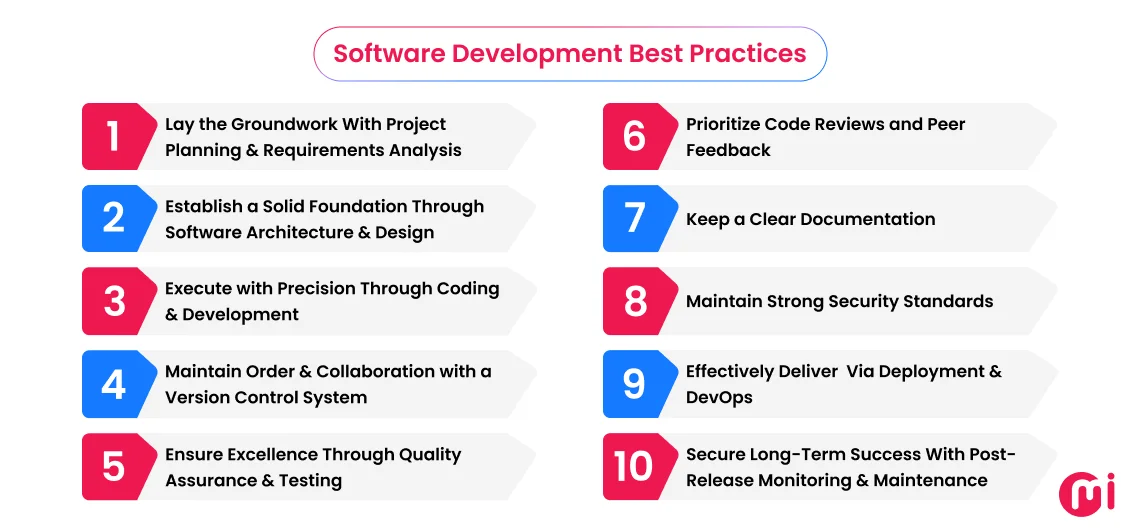Software Development Best Practices to Improve Code Quality
- Software
- July 9, 2025
Achieving success in software development depends on implementing impactful practices. This blog covers software development best practices that help enhance quality, speed, and consistency, including code reviews, continuous integration, clear documentation, and modular design. You can apply these methods to build robust, scalable software that meets both user needs and business goals.
According to software development statistics, many software development projects face delays and fail to meet their original goals in terms of time, budget, and scope. So, what separates the projects that thrive from the ones that crash and don’t succeed?
Is it a programming language?
Is it the chosen frontend or backend framework or the development team’s expertise?
While these factors do matter, success most often hinges on something more foundational: following well-established software development best practices.
Sticking to proven principles can make the difference between a scalable, maintainable system and a project nightmare. But these practices are overlooked in the rush to deliver faster or pivot quicker.
This blog breaks down the essential software development best practices that lead to cleaner code, faster delivery, and fewer bugs, helping you avoid costly software development mistakes.

Key Software Development Best Practices to Follow
Impactful software development best practices include project planning and requirements analysis, and establishing a strong foundation through software architecture & design. Also, write clean code, use version control, analyze quality through testing, prioritize peer reviews, maintain proper documentation.
Now, maintain strong security standards, effectively deliver via deployment & DevOps, secure long-term success with post-release monitoring & maintenance to build robust, scalable, and maintainable software systems. Here’s a more detailed breakdown of some industry best practices for software development.

1. Lay the Groundwork With Project Planning & Requirements Analysis
Proper planning defines the project’s scope, identifies user needs, and sets expectations for functionality and deadlines. So, plan it effectively and understand what you’re building, why it’s needed, and how success will be measured.
Here is what effective planning should include:
- Focus on the software development discovery phase, define clear goals and don’t leave room for assumptions.
- Outline both functional requirements (what your software must do) and non-functional requirements (like performance, security, or compliance standards).
- Break down tasks into smaller, trackable units with time estimates
- Identify risks early and plan for mitigation
- Align the team with shared understanding and responsibilities
You must know that precise planning is the foundation of clean, scalable, and successful software development. A clear roadmap will help you avoid costly rework, and position your project for a successful outcome.
2. Establish a Solid Foundation Through Software Architecture & Design
Software architecture is the blueprint of your system as it defines the high-level structure, components, connections, and interactions, shaping how your application behaves, scales, and adapts over time. It’s more like a building framework, and once it’s set, changes become costly. A strong architecture ensures maintainability, reliability, performance, and security right from the start.
To build a robust architecture and design:
- Map out components and their interactions and clarify system modules, data flows, and integration points.
- Choose modular, loosely coupled patterns like microservices, layered, client-server, pipe-filter to enable flexibility and scalability.
- Embed quality attributes early; design with performance, security, fault tolerance, and scalability.
- Document architecture clearly and use diagrams and interface contracts that give stakeholders and developers a unified vision.
- Follow solid design principles, in which separate concerns, encapsulate modules, avoid repetition, and limit inter-module dependencies for simplicity and maintainability.
3. Execute with Precision Through Coding & Development
Clean, readable code is the cornerstone of maintainable and scalable software. It’s not enough for code to work; it must be easy to understand, modify, and debug. You must write readable code to reduce errors, speed up onboarding, and foster team collaboration. Consistency, clarity, and simplicity should guide your coding style. Here’s how to keep your code clean:
- Use meaningful variable and function names
- Follow consistent formatting like indentation, spacing, and brace styles
- Avoid deeply nested logic and keep it simple and flat
- Write comments where necessary, especially to explain complex logic
- Stick to established coding standards for your language or team
Follow the DRY (Don’t Repeat Yourself) Principle
To write clean and maintainable code, follow the DRY (Don’t Repeat Yourself) principle. Avoid duplicating code by creating reusable functions or components whenever you notice repeated logic. This makes your codebase easier to update, reduces the chance of errors, and keeps everything more organized. Instead of copying and pasting code across multiple files, abstract the logic and reuse it.
Use YAGNI (You Ain’t Gonna Need It) Principle
Apply YAGNI (You Ain’t Gonna Need It) and focus on building what’s needed right now. Resist the temptation to add features “just in case” they’re required later. Unused features not only add unnecessary complexity but also slow down development and introduce potential bugs. Keep your scope tight and let real user needs drive feature development.
4. Maintain Order & Collaboration with a Version Control System
To manage your code effectively and collaborate with others, use a version control system like Git. Initialize your project with git init, and commit changes regularly with clear, descriptive messages. Use branches to work on new features or bug fixes without affecting the main codebase. After completing, merge your branch back into the main branch, resolving any conflicts along the way.
Push your code to a remote platform like GitHub or GitLab to back it up and collaborate with teammates. Always pull the latest changes before starting new work to stay in sync. Version control is your safety net, use it consistently.

5. Ensure Excellence Through Quality Assurance & Testing
Quality Analysis is about systematically verifying that your product meets the defined requirements and performs under real-world conditions.
To achieve this, you should:
- Develop a comprehensive testing strategy that covers unit, integration, system, and user acceptance testing.
- Automate tests whenever possible to catch regressions early and accelerate release cycles.
- Test against functional requirements and edge cases to ensure both expected and unexpected inputs are handled correctly.
- Incorporate performance, load, and security testing so your software remains stable and protected under stress.
- Fix defects promptly and re-test to maintain a high level of quality throughout development.
Having a dedicated quality assurance tester in the software development team ensures these practices are followed consistently, helping to minimize costly surprises, uphold high standards, and deliver a product your users can trust.
6. Prioritize Code Reviews and Peer Feedback
Make code reviews a mandatory step before merging any code into the main branch. Assign reviewers who have context on the relevant part of the codebase to ensure the feedback is informed and meaningful. During the review, focus on evaluating code quality, readability, maintainability, and adherence to established coding standards.
Encourage respectful and constructive feedback, and always keep the discussion centred on the code itself. Use comments to ask clarifying questions or suggest better approaches, rather than criticizing. Developers should respond to feedback promptly, make necessary changes, and resubmit for approval.
To foster a culture of continuous learning and shared ownership, rotate review responsibilities across the team. Keep pull requests concise to make reviews more effective, and document key decisions or insights from the review process. Prioritizing code reviews in this structured way helps ensure cleaner code, fewer bugs, and stronger collaboration across your team.
7. Keep a Clear Documentation
Keep a clear, thorough documentation throughout the software development life cycle (SDLC). Document your codebase, setup instructions, APIs, and architectural decisions to allow team members to understand and work with the system easily.
Use tools to keep documentation accessible and up to date. Don’t treat documentation as an afterthought but integrate it into your development workflow to reduce confusion and to make the project better.
8. Maintain Strong Security Standards
Strong security practices protect user data, uphold trust in the product, and help you avoid costly breaches or compliance issues. Building secure software means proactively identifying risks and embedding safeguards throughout the development lifecycle.
To maintain high security standards, you should:
- Follow secure coding guidelines to prevent common vulnerabilities like SQL injection, XSS, or buffer overflows.
- Implement authentication and authorization best practices to control access and protect sensitive operations.
- Encrypt sensitive data both at rest and in transit to guard against leaks and interceptions.
- Run regular code reviews and security audits to spot weaknesses before attackers do.
- Use automated security testing tools (like static analysis or dependency scanners) to catch vulnerabilities early.
- Stay updated on security patches and advisories to protect your software against emerging threats.
9. Effectively Deliver Via Deployment & DevOps
Automate your deployment pipelines to reduce manual errors and ensure every release follows the same tested process, which increases confidence in your rollouts. Use tools like CI/CD to automatically build, test, and deploy your software whenever changes are made, keeping delivery fast and consistent.
To make deployments even more robust, adopt containerization and infrastructure as code so your environments remain identical across development, staging, and production. This prevents the classic “it worked on my machine” problems.
Integrate automated health checks and performance monitoring to catch issues immediately after deployment, allowing you to roll back or fix problems before users are impacted. Promote a true DevOps culture by encouraging developers and operations teams to collaborate closely, share accountability, and provide continuous feedback.
By embracing these software development practices, you’ll streamline delivery, reduce downtime, and maintain a stable, high-performing product even as you release new updates.
10. Secure Long-Term Success With Post-Release Monitoring & Maintenance
Effective post-release practices allow you to catch issues early, keep systems running smoothly, and adapt your product as needs evolve.
Implement robust monitoring tools to track application performance, error rates, and user interactions in real time. This helps you quickly identify anomalies or bottlenecks before they escalate into bigger problems. Set up alerting systems so your team can respond to incidents immediately, minimizing downtime and protecting the user experience.
As the codebase grows, it naturally becomes more complex, refactoring helps you simplify structures, eliminate redundancies, and improve overall readability. Don’t wait until the code becomes unmanageable. Instead, adopt a habit of reviewing and cleaning up code in every sprint.
Use automated tools to detect code smells and inefficiencies, and apply small, incremental improvements. Clean, well-structured code not only prevents bugs but also makes future development faster and less error-prone.
Schedule updates to patch security vulnerabilities, optimize performance, and refine features based on real user feedback. Keep your software dependencies up to date to avoid technical debt and exposure to security risks.

Conclusion: Final Tips for Applying Industry Best Practices for Software Development
Essential software development best practices, aligned with an accurate software development estimate time, shape how teams collaborate, how efficiently products evolve, and how confidently businesses can scale. Hence, integrate these practices into your team’s daily routines, enforce them through code reviews and automated tools, and foster a culture where clean, scalable code is a shared priority.
Partner with MindInventory to Build Software That Follows Best Practices
MindInventory is a renowned software development company that engineers software solutions with precision, clarity, and long-term sustainability in mind. Our development approach is grounded in industry standards and guided by deep domain knowledge, ensuring your digital products are built on solid technical foundations.
We combine technical precision with strategic thinking to deliver solutions that are cleanly coded, modular, and easy to scale. With a strong focus on performance, clean architecture, and reliability, we help businesses avoid common pitfalls that slow down growth or inflate maintenance over time.
MindInventory delivers high-impact software solutions that drive tangible results. For instance, we developed a feature-rich fitness supplement retail platform for Nutristar, enabling them to reach over 100,000+ app downloads while helping countless users maintain their fitness goals with authentic supplements at competitive prices.
In the construction sector, we built a robust management software solution for Neo Intelligence, streamlining their operations and achieving an impressive 75% reduction in administrative time.
Whether it’s developing scalable architectures, integrating complex systems, optimizing legacy platforms, or implementing efficient workflows, our experts consistently enforce industry best practices to ensure each solution is future-ready and perfectly aligned with our clients’ growth objectives.
FAQs on Software Development Best Practices
SDLC best practices refer to a set of proven guidelines, techniques, and coding standards that help ensure high-quality, maintainable, and efficient code. These practices include principles like code readability, version control system, testing, documentation, etc. Following software development best practices reduces bugs, improves collaboration, and accelerates development.
To improve the Software Development Life Cycle (SDLC) process, organizations can adopt reliable software development methodologies like Agile or DevOps for flexibility, enhance collaboration and communication among teams, and use automated testing and CI/CD pipelines to speed up development. Regular code reviews, performance monitoring, applying SDLC best practices and incorporating user feedback early also help refine and optimize the process continuously.
The 5 main SDLC types of development cycles are Waterfall, Agile, Iterative, V-Model, and Spiral. Each follows a unique approach to software development, suited to different project needs. Choosing the right model helps ensure better planning, execution, and delivery outcomes.
There is no single best methodology in SDLC as it depends on the project’s nature, size, and goals. However, Agile is widely favored for its flexibility, iterative development, and ability to adapt to changing requirements. It promotes collaboration, faster delivery, and continuous improvement, making it ideal for dynamic and modern software projects.
The SRS model refers to the Software Requirements Specification document. It outlines all the functional and non-functional requirements of a software system, serving as a detailed guide for developers, testers, and stakeholders. The SRS ensures a clear, shared understanding of what the software must do, reducing ambiguity and guiding the entire development process.
The five core principles of object-oriented software design, known as SOLID, include: Single Responsibility Principle (SRP), Open-Closed Principle (OCP), Liskov Substitution Principle (LSP), Interface Segregation Principle (ISP), and Dependency Inversion Principle (DIP). These principles help developers build software that’s robust, extensible, and easier to maintain.













